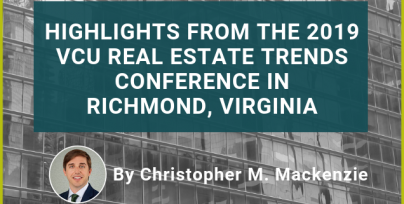Highlights from the 2019 VCU Real Estate Trends Conference in Richmond, Virginia
October 14, 2019

Christopher M. Mackenzie
Sands Anderson PC
Sands Anderson’s Commercial Real Estate Law practice group was again pleased to participate in the annual VCU Real Estate Trends Conference in Richmond, Virginia. Real estate practitioners from around the Commonwealth and beyond convened at this annual mainstay to hear experts in the field discuss the current state of the real estate industry and their forecasts for the near future. This year’s presenters, Mary Ludgin and Greg Lindsey, provided a wealth of information, with particular insights on the current state of the economy and the role technology will play in the industry’s future.
Mary Ludgin is a Senior Managing Director at Heitman and head of its Global Research, returning to the conference this year after her prior appearance in 2015. Ms. Ludgin’s presentation, “Real Estate Market Dynamics in an Era of Disruption,” set a theme for the conference – identifying the forces that are disrupting the real estate market, for good or ill, and analyzing the impacts of those changes. At a high level, Ms. Ludgin observed a slowing of the global economy amid rising geopolitical tensions – Brexit and strained U.S.-Chinese relations being a representative sample of such factors. These tensions are having effects throughout the web of entangling economic alliances that is the global economy – for example, as China buys fewer Audis, the German economy slows. Thus, we’ve seen a move from synchronized economic expansion to the increasing occurrence of multiple recession or near-recession countries.
Domestically, the U.S. economy is shifting into a lower gear; still growing, but at a slower pace. The probability of a recession over the next 12 months has risen, with Moody’s predicting a 50% chance of a recession of one form or another within a year. Ms. Ludgin reminded the audience that diversification is a helpful tool to protect a portfolio in a recession, and forecasted that the next recession likely would not be global and would not start in the housing market. Interest rates are also expected to continue to decline, but these lower rates could be beneficial for real estate investment demand. In particular, Heitman is watching the U.S. consumer confidence index, as they consider the U.S. consumer to be the last link in staving off a global downturn. If this index lags, as some studies are indicating, it could have a global impact.
Within the U.S. real estate market, Ms. Ludgin recommended keeping a weather eye on supply. Retail is out of favor, but industrial is growing – indeed, Ms. Ludgin said she cannot recall seeing industrial performing so well. She also highlighted medical office as a product that stands out as particularly strong. Speculative construction in this sector is low, and demand for medical services is driven by demographics, not macro-economics. Thus, it holds up well in a recession, making it a good alternative to office and retail. With that said, not all office is created equal. Ms. Ludgin highlighted that millennials, now the largest cohort in the workforce, do not want to work in the isolated office parks of the 1960’s and 1970’s, preferring office spaces downtown or in lively ‘live-work-play’ developments. She referenced Nashville as an interesting example of successful downtown development, and considers Richmond to be rich in opportunity for similar successes.
This focus on the trends towards urban density and a preference for walkability provided an ideal segue to the conference’s second presenter, Greg Lindsey, a Senior Fellow at New Cities. Mr. Lindsey provided a glimpse into the possible future, discussing his work as a futurist and urbanist focused on the use and development of cities. With particular respect to ‘walkability,’ Mr. Lindsey observed that while this is clearly something that is now prized by the market, the market isn’t producing enough of it to meet demand. Mr. Lindsey discussed how the market could and should react to these trends, focusing his presentation on the concept of “Live / Work / Move,” an adaptation of the well-trod notion of ‘live-work-play’ which places much greater focus on mobility as a service.
And nothing better encapsulates the idea of modern mobility than the rise of the e-scooter. Richmond already has it’s fair share of these ‘micromobility’ assets, with more arriving now. Mr. Lindsey certainly does not see this trend abating. To the contrary, while micromobility scooters and similar devices will cover short-range trips of 0-5 miles, services like Lyft and Uber will cover medium-range trips of 5 -15 miles, and car sharing services can cover the longer transfer trips beyond 15 miles. Together, these services could diminish the need for individually owned vehicles in lieu of a subscription model for all transportation needs.
These systems are also already integrating with city public transport systems, which in turn is creating tension between the two sectors as the public sector fears a loss of control over its transportation systems at the hands of the voracious technological development of the private sector. As one of Mr. Lindsey’s peer’s observed “code is the new concrete,” and thus whoever controls the code controls the public transport infrastructure. In response to this, some cities are pushing for an open source solution. For example, Los Angeles has created their own data standard for scooters and micromobility devices, which allows the locality to know where all of the scooters in the city are located and if they’re lying down, along with a variety of other data points, thus enabling them to exercise a degree of control over the system.
Obviously, this mobility revolution will have significant effects on land use. Mr. Lindsey sees changes in land use patterns that will make city streets and parking areas the next frontier of real estate development. As a harbinger of this change, Mr. Lindsey cited Softbank’s recent investment in ParkJockey, a tech startup that allows users to find and book a guaranteed parking spot in advance. This increase in efficiency, paired with the rise of autonomous vehicles, will over time likely free up real estate formerly used as parking for other uses. As another of Mr. Lindsey’s peers observed, “parking is real estate in hiding.” Again, localities are reacting, with some requiring developers to submit a plan for the reuse of any proposed new above ground parking deck when it is no longer needed for parking. And while this all seems like a concern of the distant future, autonomous vehicles are already arriving in Virginia – Optimus Ride, an autonomous vehicle company, has paired with Brookfield, a leading real estate developer, to bring autonomous transportation to Reston, Virginia this year.
Taken together, the information and insights provided by Ms. Ludgin and Mr. Lindsey will help local real estate practitioners to assess the current economic landscape of their industry and utilize emerging technologies to increase their productivity and profitability in an increasingly competitive marketplace. As you do so, Sands Anderson can assist and support your legal needs. To speak with someone from our Commercial Real Estate Team, please feel free to contact us.


